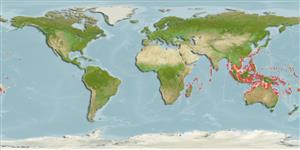Actinopterygii (ray-finned fishes) >
Perciformes (Perch-likes) >
Caesionidae (Fusiliers) > Caesioninae
Etymology: Caesio: Latin, caesius, bluish-grey, 1835; it is the same name given to the silvery metal (Cs) (Ref. 45335).
Environment / Climate / Range
Ecology
Marine; reef-associated; non-migratory; depth range 1 - 50 m (Ref. 30874). Tropical, preferred ?; 34°N - 31°S, 30°E - 116°W (Ref. 94071)
Indo-West Pacific: Red Sea and East Africa to Samoa, north to southern Japan, south to New Caledonia. Absent in the Arabian (Persian) Gulf.
Size / Weight / Age
Maturity: Lm ? range ? - ? cm
Max length : 35.0 cm TL male/unsexed; (Ref. 402); common length : 23.5 cm SL male/unsexed; (Ref. 37816)
Dorsal
spines
(total): 10;
Dorsal
soft rays
(total): 14-16;
Anal
spines: 3;
Anal
soft rays: 12 - 13. With 3-5 scales on cheek; 22-25 predorsal scales; dorsal and anal fins scaled. Supra-temporal band of scales often interrupted by a V-shaped scaleless zone anteriorly at midline. Upper peduncular scale rows usually 11 (10-12); lower peduncular scale rows usually 15 (14-15). A small process on each ventrolateral surface of basioccipital for attachment of Baudelot's ligament, a prominent concavity on ventral surface of basioccipital separating it from condyle. Post maxillary process single; posterior end of maxilla blunt. Color: Upper body bluish, lower body white to pale bluish. Golden band from above the eye, running straight along the body to upper caudal peduncle and continuing on the caudal fin to the tip of the upper lobe, becoming near black on the fin. A second similar streak in lower lobe (Ref. 48636). Head length 2.7-3.4 in SL; body depth 2.2-3.1 in SL (Ref. 90102).
Inhabits coastal areas, primarily around coral reefs. Found in schools in deep lagoons and along seaward reefs (Ref. 9710), mixing with other species of fusiliers (Ref. 48636). Juveniles used as tuna bait fish. Oviparous, with small pelagic eggs (Ref. 402).
Life cycle and mating behavior
Maturity | Reproduction | Spawning | Eggs | Fecundity | Larvae
Mating behavior is marked by six distinguishable patterns, namely: 1) nuzzling; 2) several males joining in courtship; 3) spiraling towards the surface; 4) pair spawning; 5) sperm release by sneakers; and 6) post spawning.
Nuzzling is done about 1-1.5 hours before spawning. For most of the day the fish swam slowly in school. At nearly spawning time, one or two males approach a selected female and begin pecking and pushing her swollen abdomen with their snouts. Interruption happens at this stage resulting in spawners returning to the school. With less than an hour until spawning, 2-6 males may attempt to get their abdomen as close to the female's abdomen as possible. For the pair that completes this position, a spiraling ascent to the surface occurs followed by a release of both eggs and sperm while other males come in pursuit. These sneakers release sperm at the same spot where the initial pair had released their gametes. Some spawnings may occur without sneakers getting involved in the process (Ref. 37498).
Carpenter, K.E., 1987. Revision of the Indo-Pacific fish family Caesionidae (Lutjanoidea), with descriptions of five new species. Indo-Pac. Fish. (15):56 p. (Ref. 1723)
IUCN Red List Status (Ref. 115185)
CITES (Ref. 94142)
Not Evaluated
Threat to humans
Harmless
Human uses
Fisheries: commercial; bait: occasionally
More information
ReferencesAquacultureAquaculture profileStrainsGeneticsAllele frequenciesHeritabilityDiseasesProcessingMass conversion
Tools
Special reports
Download XML
Internet sources
